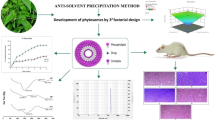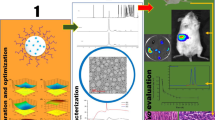Abstract
Andrographolide (AP), a phytoconstituent of Andrographis paniculata is reported as a potent hepatoprotective agent. However, utility of this molecule is restricted due to its low aqueous solubility, gastric instability and hence low bioavailability. It was aimed to formulate and characterize AP-loaded, natural biopolymer stabilized, multilayered nano-hydrocolloid delivery system. Nanoemulsion (NE) was formulated using layer-by-layer (LbL) technology via electrostatic deposition of chitosan over alginate encrusted o/w NE by ultra-sonication. Improved transparency and stability of NE were observed with increasing sonication time. Best stability was obtained after 20 min sonication and particle size of the multilayered NE was measured in the range of 90.8–167.8 nm. Transmission electron microscopy confirmed the progressive layering of nanosized NE. Higher magnitude of zeta potential (i.e., 22.9 to 31.01 mV) confirmed higher stability and coating of alginate layer over NE surface for the period of 3 months. NE showed strategic release pattern when assessed in vitro in various simulated biological fluids of GIT in timed pattern. Multilayered NE showed significant modulation in liver function test (ALT, ALP, AST, TBIL, DBIL, and liver glycogen) and serum cytokines (TNF-α, IL-6, IL-10, and IL-β) when assessed in vivo in galactosamine-lipopolysaccharide intoxicated mice. In conclusion, the andrographolide engrained multi-layered NE enhanced the solubility, stability and henceforth assured the increased availability in simulated biological fluids. The in vivo study exhibited the significantly improved hepatoprotection by andrographolide when delivered in stable multi-layered NE carrier systems.





Similar content being viewed by others
References
Panossian AG, Hovhannisyan A, Mamikonyan G, et al. Pharmacokinetic and oral bioavailability of andrographolide from Andrographis paniculata fixed combination Kan Jang in rats and human. Phytomedicine. 2000;7:351–64.
Thingale AD, Shaikh KS, Channekar PR, Galgatte UC, Chaudhari PD, Bothiraja C. Enhanced hepatoprotective activity of andrographolide complexed with a biomaterial. Drug Deliv. 2014;22:117–24.
Chellampillai B, Pawar AP. Improved bioavailability of orally administered andrographolide from pH-sensitive nanoparticles. Eur J Drug Metab Pharmacokinet. 2011;35:123–9.
Sinha J, Mukhopadhyay S, Das N, Basu MK. Targeting of liposomal andrographolide to L. donovani-infected macrophages in vivo. Drug Deliv. 2000;7(4):209–13.
Jain PK, Khurana N, Pounikar Y, Gajbhiye A, Kharya MD. Enhancement of absorption and hepatoprotective potential through soya-phosphatidylcholine-andrographolide vesicular system. J lipos Res. 2013;23(2):110–8.
Ren K, Zhang Z, Li Y, et al. Physicochemical characteristics and oral bioavailability of andrographolide complexed with hydroxypropyl-beta-cyclodextrin. Die Pharmazie. 2009;64(8):515–20.
Bothiraja C, Shinde MB, Rajalakshmi S, Pawar AP. Evaluation of molecular pharmaceutical and in-vivo properties of spray-dried isolated andrographolide-PVP. J Pharm Pharmacol. 2009;61(11):1465–72.
Roy P, Das S, Bera T, Mondol S, Mukherjee A. Andrographolide nanoparticles in leishmaniasis: characterization and in vitro evaluations. Int J Nanomedicine. 2010;5:1113–21.
Choi AJ, Kim CJ, Cho YJ, Hwang JK, Kim CT. Characterization of capsaicin-loaded nanoemulsions stabilized with alginate and chitosan by self-assembly. Food Bioprocess Technol. 2011;4:1119–26.
Kotta S, Khan AW, Pramod K, Ansari SH, Sharma RK, Ali J. Exploring oral nanoemulsions for bioavailability enhancement of poorly water-soluble drugs. Expert Opin Drug Deliv. 2012;9(5):85–598.
Parekh G, Pattekari P, Joshi C, et al. Layer-by-layer nanoencapsulation of camptothecin with improved activity. Int J Pharm. 2014;465:218–27.
Ramasamy T, Tran TH, Choi JY, et al. Layer-by-layer coated lipid–polymer hybrid nanoparticles designed for use in anticancer drug delivery. Carbohyd Polym. 2014;102:653–61.
Huguet ML, Neufeld RJ, Dellacherie E. Calcium-alginate beads coated with polycationic polymers: comparison of chitosan and DEAE-dextran. Process Biochem. 1996;31:347–53.
Ilium L. Chitosan and its use as a pharmaceutical excipient. Pharm Res. 1998;15:1326–31.
Yao KD, Peng T, Yin YJ, Xu MX, Goosen MFA. Microcapsules/microspheres related to chitosan. J Macromol Sci. 1995;35C:155–80.
Wang Z, Zhang X, Gu J, Yang H, Nie J, Ma G. Electrodeposition of alginate/chitosan layer-by-layer composite coatings on titanium substrates. Carbohyd Polym. 2014;103:38–45.
Chen MX, Li BK, Yin DK, Liang J, Li S, Peng DY. Layer-by-layer assembly of chitosan stabilized multilayered liposomes for paclitaxel delivery. Carbohyd Polym. 2014;111:298–304.
Mishra N, Yadav NP, VK Rai, Sinha P, Yadav KS, Jain S, Arora S. Efficient hepatic delivery of drugs: novel strategies and their significance. Biomed Res Int. 2013: 20. doi.10.1155/2013/382184.
Sezer AD, Akbuga J. Release characteristics of chitosan treated alginate beads: II. Sustained release of a low molecular drug from chitosan treated alginate beads. J Microencapsul. 1999;16:687–96.
Rai VK, Yadav NP, Sinha P, et al. Development of cellulosic polymer based gel of novel ternary mixture of miconazole nitrate for buccal delivery. Carbohyd Polym. 2014;103:126–33.
Shutava TG, Pattekari PP, Arapov KA, Torchilin VP, Lvov YM. Architectural layer-by-layer assembly of drug nanocapsules with PEGylated polyelectrolytes. Soft Matter. 2012;8:9418–27.
Tang XH, Gao J, Chen J, et al. Mitochondrial modulation is involved in the hepatoprotection of Limonium sinense extract against liver damage in mice. J Ethnopharmacol. 2008;120:427–31.
Liong EC, Xiao J, Lau TY, Nanji AA, Tipoe GL. Cyclooxygenase inhibitors protect D-galactosamine/lipopolysaccharide induced acute hepatic injury in experimental mice model. Food Chem Toxicol. 2012;50:861–6.
Wu YL, Lian LH, Jiang YZ, Nan JX. Hepatoprotective effects of salidroside on fulminant hepatic failure induced by D-galactosamine and lipopolysaccharide in mice. J Pharm Pharmacol. 2009;61:1375–82.
Yadav NP, Dixit VK. Hepatoprotective activity of leaves of Kalanchoe pinnata Pers. J Ethnopharmacol. 2003;86:197–202.
O’Brien RW, Midmore BR, Lamb A, Hunter RJ. Electroacoustic studies of moderately concentrated colloidal suspensions. Faraday Discuss Chem Soc. 1990;90:301–12.
Jena S, Das H. Modeling of particle size distribution of sonicated coconut milk emulsion: effect of emulsifiers and sonication time. Food Res Int. 2006;39:606–11.
Lin CY, Chen LW. Emulsification characteristics of three- and two-phase emulsions prepared by the ultrasonic emulsification method. Fuel Process Technol. 2006;87:309–17.
Pilli S, Bhunia P, Yan S, LeBlanc RJ, Tyagi RD, Surampalli RY. Ultrasonic pretreatment of sludge: a review. Ultrason Sonochem. 2011;18:1–18.
Zhang HL, Wu SH, Tao Y, Zang LQ, Su ZQ. Preparation and characterization of water-soluble chitosan nanoparticles as protein delivery system. J Nanomat. 2010;2010:5. doi:10.1155/2010/898910.
Nielloud FMMG. Formulation concepts for the emulsion maker. Jean LS pharmaceutical emulsions and suspensions. Marcel Dekker, Inc: New York; 2000. p. 19–68.
Gamboa JM, Leong KW. In vitro and in vivo models for the study of oral delivery of nanoparticles. Adv Drug Del Rev. 2013;65:800–10.
Ribeiro AJ, Silva C, Ferreira D, Veiga F. Chitosan-reinforced alginate microspheres obtained through the emulsification/internal gelation technique. Eur J Pharm Sci. 2005;25:31–40.
Acknowledgments
The authors are thankful to Council of Scientific and Industrial Research (CSIR), New Delhi, India, for providing financial assistance to Nidhi Mishra as CSIR-SRF (Grant no. 111102/2K1011) and CSIR-Central Institute of Medicinal and Aromatic Plants (CSIR-CIMAP), Lucknow, India for providing necessary facilities under the Network Project ChemBio (BSC 203).
Author information
Authors and Affiliations
Corresponding author
Ethics declarations
Conflict of Interests
The authors declare that they have no conflict of interests.
Rights and permissions
About this article
Cite this article
Mishra, N., Yadav, K.S., Rai, V.K. et al. Polysaccharide Encrusted Multilayered Nano-Colloidal System of Andrographolide for Improved Hepatoprotection. AAPS PharmSciTech 18, 381–392 (2017). https://doi.org/10.1208/s12249-016-0512-4
Received:
Accepted:
Published:
Issue Date:
DOI: https://doi.org/10.1208/s12249-016-0512-4




